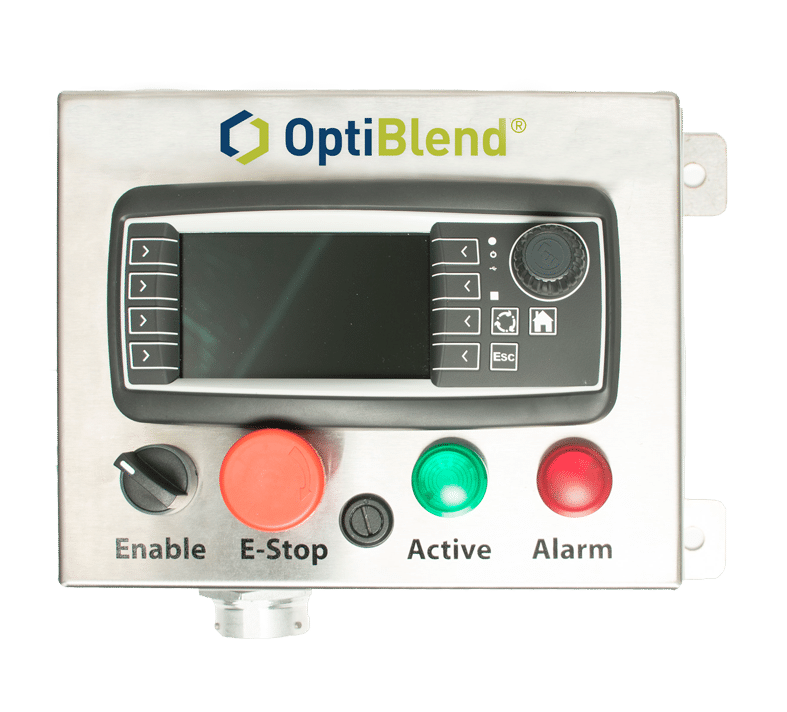Dual Fuel Conversion Kit : Site Installation
Dual Fuel Conversion Kit: Site Installation
The OptiBlend® system has been designed isochronous governor controlled diesel engines with a narrow RPM operating range (+/- 500 RPM). However, the system has been applied to variable speed pump and frack truck diesel engines. The dual fuel kit can be used for continuous-duty prime power, stand-by, or pumping applications. The dual fuel kit is currently outfitted on applications as low as 20kW and up to 4MW but can be outfitted on larger applications as well. The OptiBlend kit will work with a variety of hydrocarbon gasses. Dry, clean pipeline natural gas typically provides the best overall performance. However, the OptiBlend kit has been used with hydrogen + natural gas (HCNG), syngas, biogas, propane, and wellhead gas. Lower quality gasses may produce reductions in engine efficiency and performance.
Diesel fuel compression ignition engines retrofitted with the dual fuel kit use diesel as the primary fuel. While diesel displacement by natural gas may be greater than 50% at some operating ranges, diesel fuel is always required to ignite the natural gas.
Below, we will list specific “site” installation topics that require planning prior to beginning the install process on your power generator.
Indoor/Outdoor considerations and Operating Temperatures
Indoor installation requires adequate ventilation to prevent gas accumulation caused by undetected leaks. Positive outside air flow and exhaust venting should already be in place and permitted. Additional permitting of gaseous fuel installation/operation maybe required by local authorities. The OptiBlend® kit should not be operated above 60°C. Outdoor installation in areas where temperatures fall below -15°C will require a cold weather package to operate. Temperatures below -40°C are outside operational range for an OptiBlend® system.
Gaseous Displacement Fuel
Summary of Typical OptiBlend® Gas Composition Limits and Specifications (for systems designed and commissioned for pipeline-quality natural gas)
Water:
Below saturation limit at all gas supply conditions (non-condensing). H2O [ppm max] = (10^ (-4374/ (460 +T [°F min]) + 13.825))/ (14.7+P [psig max])
Hydrogen Sulfide (H2S):
Below 10 ppm without restriction. Above 10 ppm and below 500 ppm with loads above 25% with coolant and oil at normal operating temperature. Positive crankcase ventilation is highly recommended Higher than 500 ppm not recommended – consult with engine OEM.
Inerts (CO2, N2, He, Ar) and Low Heating Value Gas (LHV): No safety or engine durability limit, but dual-fuel control may not be able to reach displacement targets with a lower heating value (LHV) less than 750 BTU/SCF without system changes.
Oxygen:
Less than 4% to stay safely outside the rich flammability limit. Lower Heating Value (LHV): 950 BTU/SCF typical. Below 1050 BTU/SCF with no re-tune.
Non-Methane Hydrocarbons:
After re-calculating the gas composition with any inert components and oxygen discarded:
- Less than 15% total non-methane hydrocarbons
- Less than 10% ethane
- Less than 5% propane + heavier hydrocarbons
Methane Number (MN):
Not very useful for unusual gas mixtures (syngas, biogas)
- Above MN = 80 without restrictions.
- Above MN = 70 for engines with compression ratios of 17 or lower.
General Site and Generator Considerations for Dual Fuel Installation
Some important items to address when considering dual fuel installation on an existing or new diesel generator include:
- Is there enough gas onsite? 6-9 scfh/kW is required.
- Has the gas been regulated to 3-5 psi?
- If the gas is not pipeline natural gas, has the gas analysis been approved by Eden Innovations LLC?
- Does the end user need building management system communication?
- Does the customer want real time diesel flow and diesel displacement? Electronic ECU with J1939 or, for mechanically governed engines, diesel flow meters are required.
- Has the engine previously been commissioned on diesel?
- Will a load bank be available during commissioning? This is required.
 Bi-Fuel Diesel Engine Conversion - OptiBlend bi-fuel retrofit system uses a gas train & electronic software device to constantly monitor engine performance & gaseous flow for safe & efficient operation.
Bi-Fuel Diesel Engine Conversion - OptiBlend bi-fuel retrofit system uses a gas train & electronic software device to constantly monitor engine performance & gaseous flow for safe & efficient operation.  Bi Fuel System Components - OptiBlend bi-fuel retrofit system uses a gas train & electronic software device to constantly monitor engine performance & gaseous flow for safe & efficient operation.
Bi Fuel System Components - OptiBlend bi-fuel retrofit system uses a gas train & electronic software device to constantly monitor engine performance & gaseous flow for safe & efficient operation.  OptiBlend : Bi-Fuel Engine - OptiBlend bi-fuel technology optimally retrofits 200-2000 kVA, doubling runtime while significantly reducing operations cost. ROI is often within the first year of operation.
OptiBlend : Bi-Fuel Engine - OptiBlend bi-fuel technology optimally retrofits 200-2000 kVA, doubling runtime while significantly reducing operations cost. ROI is often within the first year of operation.
 Optiblend Bi-Fuel Diesel Engine Conversion - Adding a secondary gaseous fuel…
Optiblend Bi-Fuel Diesel Engine Conversion - Adding a secondary gaseous fuel…  Diesel Equipment : Bi-Fuel Conversion - An OptiBlend dual fuel retrofit…
Diesel Equipment : Bi-Fuel Conversion - An OptiBlend dual fuel retrofit…  Bi-Fuel Diesel Engine Conversion - OptiBlend's dual fuel diesel engine…
Bi-Fuel Diesel Engine Conversion - OptiBlend's dual fuel diesel engine…  Bi-Fuel Diesel Natural Gas Power Generator Conversion - OptiBlend dual fuel retrofit systems…
Bi-Fuel Diesel Natural Gas Power Generator Conversion - OptiBlend dual fuel retrofit systems…  Bi Fuel Gas Train - OptiBlend dual fuel gas train…
Bi Fuel Gas Train - OptiBlend dual fuel gas train…  Bi Fuel Air Gas Mixer Valve (AGM) - OptiBlend dual fuel conversion uses…
Bi Fuel Air Gas Mixer Valve (AGM) - OptiBlend dual fuel conversion uses…  Bi-Fuel Control Valve - OptiBlend dual fuel conversion kits…
Bi-Fuel Control Valve - OptiBlend dual fuel conversion kits…  Bi-Fuel Control Panel - OptiBlend dual fuel conversion kits…
Bi-Fuel Control Panel - OptiBlend dual fuel conversion kits…  Bi Fuel Engines - Bi-fuel vs. dual fuel, what…
Bi Fuel Engines - Bi-fuel vs. dual fuel, what…



